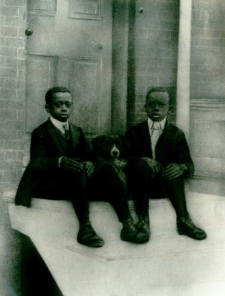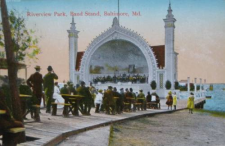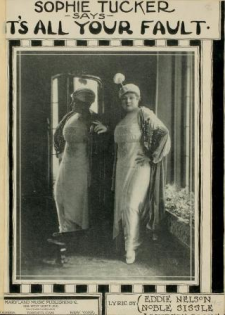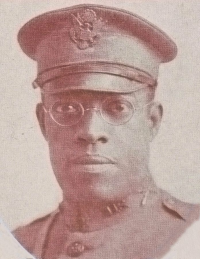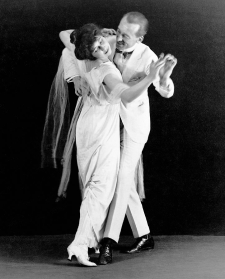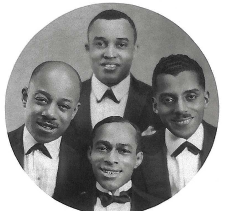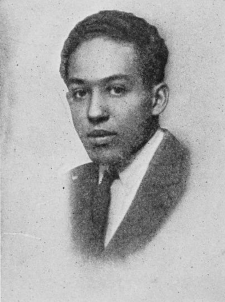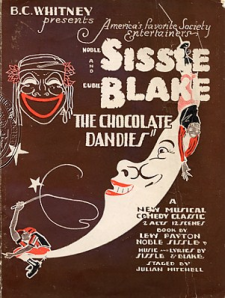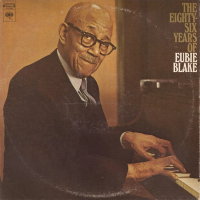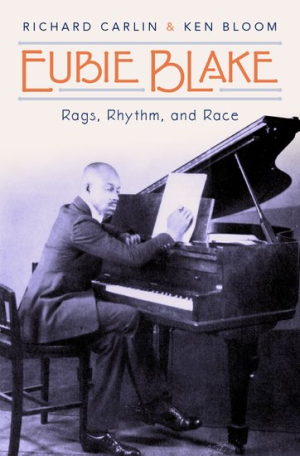.
.
photo courtesy Richard Carlin

Ken Bloom and Richard Carlin, co-authors of Eubie Blake: Rags, Rhythm, and Race
.
.
___
.
.
…..A legendary composer of American popular song and jazz during the 20th century, Eubie Blake has long been known for his charming character and impressive life span, but his role on over 100 years of American culture has been mostly underappreciated.
…..The Baltimore native began his career in that city’s dance halls and bordellos before moving to New York as a young man, where he soon became a towering figure of the Harlem Renaissance. Along with performing partner Noble Sissle, in 1921 Blake created the smash Broadway hit Shuffle Along, now recognized for integrating Broadway and road shows, and for introducing many of that generation’s most important Black stars – among them Josephine Baker, Lottie Gee, Florence Mills, Paul Robeson and Fredi Washington.
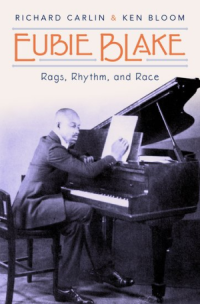
…..In Eubie Blake: Rags, Rhythm, and Race, the Broadway and popular music authorities Richard Carlin and Ken Bloom write that the success of Blake’s Shuffle Along “proved that Black shows were viable on Broadway, and subsequent productions gave a voice to great songwriters and performers, as well as speaking to a previously disenfranchised Black audience.” However, “as successful as Shuffle Along was, racism and bad luck hampered Blake’s career.”
…..Despite these challenges, even in his 90’s Blake played at major jazz festivals, in Broadway shows, and on television and recordings, and, in 1981 – two years before his death at age 96 – received the Presidential Medal of Freedom.
…..In an interview with Jerry Jazz Musician Editor/Publisher Joe Maita, Carlin and Bloom speak about Blake and their insightful and timely book – an important portrait of the man and the musical world his work helped reshape.
.
.
___
.
.
photo courtesy of the authors
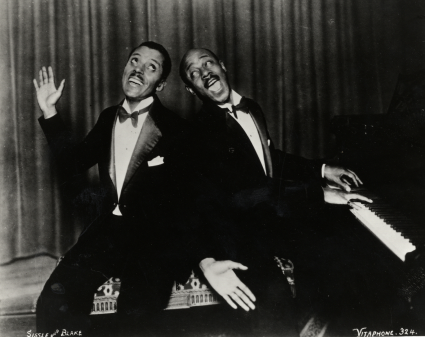
Noble Sissle and Eubie Blake, c. 1923
.
“Eubie was best known for finger-busting, virtuosic piano solos like “Charleston Rag” and “Troublesome Ivories,” along with classic songs like “I’m Just Wild About Harry” and “Memories of You”; his music ranged from the groundbreaking syncopated ragtime of his youth through the creation of some of the greatest show tunes to ever grace the Broadway stage. Plus, he was one of the finest natural performers, whose stage presence was undiminished even as his health declined in his later 90s. While Blake achieved significant fame later in his life, the true breadth of his achievements has not been adequately documented before. Spanning nearly a century of creativity, Blake’s work taken as a whole makes him one of the most important American musicians, black or white, of the 20th century.”
-Richard Carlin and Ken Bloom
.
.
Listen to Eubie Blake and Noble Sissle perform “Love Will Find a Way,” from their 1921 musical Shuffle Along (Harbinger Records).
.
.
JJM Thanks to both of you for joining me. I enjoyed your book and it was wonderful to revisit Eubie Blake’s life and career. I saw Eubie in the mid-1970’s at Zellerbach Auditorium in Berkeley, and your book brought back many wonderful memories of that evening. What inspired the two of you to write a biography of Eubie Blake?
KB We produced an album for Harbinger Records of the original recordings from Blake’s and Noble Sissle’s show Shuffle Along, and surprisingly Richard and I won a Grammy Award for Best Album Notes for that, which was very strange because we were up against big box sets with extensive booklets. So, because we were so successful with that, and since that was so easy, we thought, let’s just write a biography of Eubie Blake!
RC Al Rose had written a biography of Eubie Blake in 1979 that was sort of an oral history, as was the book by William Bolcom and Robert Kimball called Reminiscing with Sissle and Blake. When we discovered that Eubie Blake’s two wives were both incredible packrats and that all this material was available in archives, it opened up a lot more information about his life. For me, it was the appeal of writing about someone who had such a long career that traced not only his history, but the history of Black songwriters through the 20th century as well. That was something we tried very much to incorporate into the book.
JJM Other than writing the liner notes to the Harbinger release, had you ever written together before?
KB No, we hadn’t.
RC Ken and I have known each other for over 25 years. I was an editor at Schirmer Books when Ken and I met, and I was actually his editor for several of the books he wrote, so we had collaborated in that “editor/author” kind of way. What was great about this collaboration was that Ken has such a deep knowledge about the history of Broadway and popular song, while I have knowledge about the music industry and the role of African Americans within it, having written about that. So, we complemented each other in that way. And, while Ken has co-written books, I had not, so this was a new and exciting experience for me.
KB And, amazingly, we never had any fights or arguments about anything. We knew each other so well and were always on the same wavelength. (laughter)
JJM And you share a deep love for Eubie Blake…
KB Absolutely.
JJM What sparked Blake’s interest in music?
Howard “Hop” Johns and Eubie Blake. The authors believe Blake was about eight years old
RC Eubie told various stories about this. When you hear him speak, you are immediately struck by the fact that he has an incredible ear for music and for speech. Apparently, when he was a very young child his parents took him down to a Baltimore food market in the evening, when the vendors would be selling off their leftovers. Eubie’s family lived in the slums of Baltimore – his father worked on the docks unloading cargo – so they had to scrimp and save wherever they could. One evening when he was about three or four years old, Eubie claims he heard someone demonstrating a pump organ in a music store and wandered off from his parents, who were of course alarmed since they didn’t know what happened to him. When they found him they saw he was transfixed by this pump organ, and of course the dealer leapt on this and convinced his parents to buy an organ on time, one of those pay one-dollar-a-month deals. Eubie claimed that from the very beginning he could pick out a song melody and hear the harmony, and one of the first was “Marching through Georgia,” which was a popular song of that period that he said bands would march in the street playing. He certainly had a remarkable ear, and very quickly picked up a lot of the popular styles of the day, including the ragtime piano style that he could hear being played outside the bars and bawdy houses in his neighborhood.
KB He was also influenced by the English composer Leslie Stuart, so he had a wide range of tastes. It isn’t as if he were only interested in the kind of music that you’d hear in a bawdy house, he was also interested in the more sophisticated early popular songs that were going around at the time. So, he had a lot of a wide range of influences in his music.
JJM He claimed Franz Liszt was an influence…
RC That’s right. He had a slightly older neighbor who taught him the rudiments of playing the piano, and at that time they were very much based on the classics. By the time he was a young teenager, he was already working professionally, which is also quite remarkable for that time.
Because he could play the piano and make money playing at night, he never had to work manual labor, which would have pretty much been the experience of almost every other Black child in his neighborhood. And he had such a great ear he was like a human jukebox, able to play just about any music that was requested, which would have been everything from dance music to popular songs to classical selections. In those days there wasn’t that much of a distinction like we think today – someone may have requested him to play the “Blue Danube Waltz,” followed up with “St. Louis Blues,” and then something like a hymn. He had to be very adept at picking up the latest tunes.
Another thing is that Eubie could play in any key, which was unusual for self-trained pianists at the time. Many untrained pianists, including Irving Berlin, only played on the black keys, which Eubie made a joke about – that Black pianists would only play on the black keys because they knew better than to touch the white ones. But Eubie could play in any key and could adapt – if the singer started singing a pop song in a totally different key than it was written in, he could immediately play it, which is another testimony to his incredible musical ear and talent.
KB And even at that early age he had a recognizable style. There’s a story about a friend of his mother’s telling her that she heard Eubie playing last night, and his mother responded by saying, “What do you mean? Eubie was in bed!” The woman said that she was walking by Aggie Shelton’s bawdy house and heard Eubie playing, which was true. So, this woman could recognize Eubie’s style, even at that young age.
JJM Early on, the boxer Joe Gans had an impact on Eubie’s life…
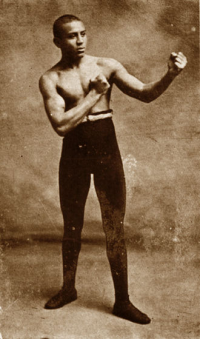
Joe Gans in 1899
RC Yes, Eubie told various stories about first meeting Gans. When he was very young, Eubie started out playing sawdust dives – places that even he found uncomfortable to work in – but as he established himself, he moved up to play for more classy establishments, and also for Black social clubs. After winning a famous boxing match in Goldfield, Nevada in 1908, Gans came home to Baltimore and opened up the Goldfield Hotel, which had an elaborate bar that became a gathering place for both Black and white society. Gans hired Eubie at the rate of $60 a week, which was a tremendous amount, especially when you consider that his father earned $9 a week as a foreman on the docks – when he was working. It was at that time he befriended Gans, who was a key player in Baltimore’s Black society.
KB Eubie’s mother didn’t like him playing – she wanted him to be a church organist, basically – but when he started bringing home real money, all of her objections to him playing this kind of music sort of faded away.
JJM How old was he at that time?
RC He started playing when he was a young teenager. It’s hard to date things exactly, one reason being that Eubie added to his age. He was born in 1887, so by 1908, when he played for Gans, he would have been in his late teens or early 20’s.
JJM What was an early songwriting success of his?
The bandstand at Baltimore’s Riverview Park
.
The sheet music to Sissle and Blake’s “It’s All Your Fault,” popularized by Sophie Tucker
RC His real breakthrough came in 1915, when he was playing for the local bandleader Joe Porter. They played at Riverview Park, which was a popular place for Black people to go in Baltimore because it was served by the streetcar and there was no admission. Riverview was quite an elaborate Park, with a Ferris wheel, a bandstand with a classical orchestra, as well as a dance band that Porter led.
Eubie was working with Porter as his pianist when, in the summer of 1915, Porter introduced him to a new vocalist who was joining the band named Noble Sissle, who was a real go-getter and who had already written lyrics for songs by this time. Eubie and Sissle became partners and wrote a song called “It’s All Your Fault,” and Sissle suggested to Eubie that since Sophie Tucker was coming to town, they should go backstage and, because she was famous for singing songs written by Black songwriters – even though she was white and Jewish – pitch this song to her. Eubie thought that was really crazy – who would have the nerve to do that? But Sissle approached Sophie and she agreed to do the song, and since she recognized that they were just getting started, even offered to have the arrangements written, which was unusual because the songwriter would generally have to pay for that to be done. The song wound up being a local hit that Eubie said sold thousands of copies of sheet music in Baltimore and Washington, D.C., and was marketed in the local papers as the “big hit by Sophie Tucker.” Her picture was on the sheet music cover, which undoubtedly helped the sales.
.
A musical interlude…Listen to the 1919 recording of James Reese Europe’s 369th Infantry “Hellfighter’s Band” play “On Patrol In No Man’s Land,” with Noble Sissle (vocal)
.
JJM The bandleader, composer, and arranger James Reese Europe was influential on Sissle and Blake…
KB Yes. Europe was many things, among them a bandleader in New York for white society, and he gave Sissle and Blake the idea that they could be more than just a team, they could reach a wider audience and actually meet society people. That that had a lot to do with their confidence going forward because they were successful with all kinds of audiences.
James Reese Europe, c. 1919
RC Before his death in 1919, one of Europe’s dreams was to produce an all-Black acted and produced show on Broadway, which Sissle and Blake were able to realize with Shuffle Along. Prior to that, Europe had already composed many songs for the earlier Cole and Johnson musicals at the turn of the century. As Ken said, Europe made a point of presenting Black musicians in formal clothes rather than in a minstrel setting – which was basically the only way Black entertainers were presented previously – and he even rented out Carnegie Hall for several concerts. He made a point of promoting his band as a legitimate orchestra, and his bands were in such demand that by World War I he was running four or five different orchestras that would perform every night, much in the way that Paul Whiteman had associated bands. Europe would just go from gig to gig and kind of wave at people. So, Europe was a very important figure.
He also founded the Clef Club, which was a kind of early union and social club for Black musicians. Previously, if a wealthy white family wanted to book a Black band for an engagement, they would have to go to a dive bar – which wasn’t always very comfortable for them – so Europe came up with the idea of having a central booking office, which gave it legitimacy. During World War I, when Europe and Sissle went overseas and played in Europe’s band The Hellfighters, Eubie ran the stateside orchestra, which turned out to be important training for him.
KB Yes, and as Richard said, Europe also influenced them because they’d perform in formal clothing, so when Eubie and Sissle got into vaudeville, they always wore tuxedos. They were a class act – they didn’t put blackface on, and they didn’t do all the southern tropes that other performers like Bert Williams did. They presented themselves in a way that Europe would have.
JJM The relationship Europe had with the dancers Vernon and Irene Castle was culturally important. How did that relationship impact Sissle and Blake?
photo by Francis Benjamin Johnston/Wikimedia Commons
Irene and Vernon Castle, c. 1912
RC The Castles not only brought African American vernacular dance into popular society, they made it acceptable and popular. They ran a dancing school, and Sissle tells an amusing story about how when they were first playing for these white dancers, they only really knew how to dance fast to polkas, and people would be running around the room, dancing a basic two-step. Sissle claimed that he was the one who suggested to Europe that they play a blues, and Europe came up with the idea of playing “St. Louis Blues,” the famous W.C. Handy composition, which introduced the slow drag, more relaxed, more syncopated dancing style that came from African American forms. The Castle’s then adapted this into dances like “The Castle Walk” and eventually the “Foxtrot.” These were strong influences on Sissle and Blake. One of the things Shuffle Along is famous for is its unique use of a chorus line and the style of dancing that was done, which also reflected those same influences and traditions.
Because Europe was associated with the Castle’s – the top-ranking social dancers of their day – he got a contract with Victor Records and was promoted like a white band would have been at the time, which was a big step forward for any Black musician of that period.
JJM Sissle and Blake had a lifelong relationship. How would you characterize their relationship early on, and what made it a success?
KB Part of it is because each sort of opened up the other one. Eubie was very outgoing and down to earth, while Sissle had higher aspirations, which sometimes later got in the way of their collaboration. So, while they each brought something else to the combination, on a basic level they agreed completely and fed off of each other – the total became more than just the two of them.
photo courtesy of the authors
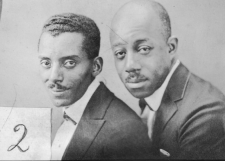
Noble Sissle and Eubie Blake
RC Sissle was college educated, while Eubie was not – although he was highly self-educated. Sissle basically attended all-white schools, and Eubie commented that Sissle was much more comfortable with white people than he was. Sissle had an incredible drive and became the engine that drove their success. For example, Eubie remained in Baltimore when Sissle first moved to New York to work with James Reese Europe, and it took Sissle a couple of months to convince Eubie to leave – it is likely that Eubie never would have gone outside of Baltimore if it hadn’t been for that inspiration, because he was more easygoing, he was happy where he was, and he was making plenty of money. So, if not for Sissle, Eubie may never have achieved the success he did. Sissle was very important, as were Eubie’s two wives later on because they basically managed his career. Eubie wasn’t an adept self-manager or self-promoter, and this comes up several times in the biography. He had to deal with a lot of the racism and inequities in the music business, and he wasn’t really talented at doing that.
.
A musical interlude…Listen to Sissle and Blake perform “Bandana Days,” from Shuffle Along
.
JJM The book is filled with at times disturbing, racist reviews, especially of shows prior to Shuffle Along – a reminder of the extreme and transparent racism that existed during the time of the show’s creation. Given the era we are living in now, I would recommend your book to readers for that alone so they can be reminded of the racial climate in which these great musicians created and performed.
RC Yes, and it’s not only the critical reception, which is one area that requires closer understanding, but also the way the music business functioned. Something I found shocking was that, because Eubie kept such precise records – including ledger books, contracts, and the nuts and bolts of being a working musician – you could see how many times he was supposed to be paid “X,” but was actually paid far less, and he had very little recourse. Even as recent as the 1970s, when the revue Eubie was run on Broadway and when one would have thought the world was much more enlightened, he was still underpaid and would have been taken advantage of even more if he didn’t have an aggressive lawyer. So, it’s kind of like that old saying, “the more things change, the more they stay the same.” Songwriters traditionally have been poorly treated by the music business – and Black songwriters especially so – but there was very little recourse for them because that was the system they had to work in.
KB And the racism was an “easy” racism for white people to use. Today most people watch their language, but then they didn’t, they just laid it all out there. In an odd way I actually think the racism helped Shuffle Along because when it opened on Broadway, the audience expected a “coon show,” but instead here was a fairly sophisticated show with real people – not minstrel-type performers – and that surprised white audiences.
RC That was quite a radical and dangerous thing to do. One of the things that the show’s creators wanted to do was to portray a romance between a middle-class Black couple in ways that would have been found in a white show of the period. Portraying that kind of affection by a Black couple was the total breaking down of a social taboo. There was actually a lot of concern among the show’s creators that there would be rioting if this went ahead, so it was a brave step to take. Because of the brilliance of the show, they were able to break that barrier.
JJM A Black critic writing for The New York Age wrote, “White audiences…do not want colored people to indulge in too much love-making. They will applaud if a colored man serenades his girl at the window, but if, while telling of his great love in song he becomes somewhat demonstrative…then exceptions are taken. It may be the general impression prevails that Negroes are only slightly acquainted with Don Cupid; or maybe it is thought that they have no business being ardent lovers.” That’s the climate that this show opened and, as Ken said earlier, people were likely expecting Shuffle Along to be a “coon show” that was more typical of the era’s Black entertainment. So, this was a courageous show for them to create and perform. What was the impetus for them creating Shuffle Along?
The creators of Shuffle Along; Eubie Blake, Flournoy Miller, Noble Sissle, and Aubrey Lyles (clockwise from left)
KB I don’t think there was a real impetus, they just sort of fell into it. Sissle was the driving force of keeping it very respectful, and the blackface comics Flournoy Miller and Aubrey Lyles provided more of the lowdown humor. The show sort of had something for everybody in a strange way, because you had the love story as well as the comedy by Miller and Lyles – which was more to be expected. The other thing is that Shuffle Along was also the first show that had integrated audiences. Initially, the Black audience was in the upper balcony and the white audience was below, and even that was a big step. Little-by-little the Black audience was able to sit in a separate orchestra section, and then, little-by-little, they were able to sit next to whites, and white audience members began to understand that these were people too. So, I think that was a big impact of the show.
RC Miller and Lyles, who had also toured white vaudeville, were a notch above acts that were relegated to the “Blacks Only” theatres, and they and Sissle and Blake all wanted to break into white Broadway, and their ticket to that was to create Shuffle Along. Miller and Lyles had established themselves on the stage in Chicago at the famous Pekin Theatre, which was an all-Black theatrical company that was very important at the turn of the century. They had a stockpile of not only comic situations but also play scripts of various kinds, including one called The Mayor of Dixie, which provided the basic structure for Shuffle Along. I don’t think we should downplay the fact that they also were envisioning a Black theater that was more sophisticated, and they knew they needed a lyricist and composer who could share that vision. It really was a marriage made in heaven that created this incredible success.
.
A musical interlude…Listen to Eubie Blake (piano), Noble Sissle (vocal) and Ruth Williams (vocal) perform “I’m Just Wild About Harry”
.
JJM How did they finance Shuffle Along?
KB With great difficulty…
RC The son of the theatrical producer John Cort and his manager became interested. Cort put up the money, and he had a storehouse full of old costumes and sets from various other productions that were repurposed. Sissle, Blake, Miller and Lyles delivered the script and the music, but they didn’t put up any money, and were actually co-producers of the show, which was a very radical step for the time. What it meant was that when Shuffle Along became a tremendous success they were suddenly extremely wealthy, which was an unusual position even for white actors, not to mention Black ones. So, it was a unique kind of collaboration. When they came to New York the show was $18,000 in debt and was barely surviving – they had to constantly beg, borrow or steal for car fare, for example, or Cort would have to pay for train tickets. Had it not been a success in New York, it would have been quite a different story.
JJM What role did critics have in helping make Shuffle Along a success?
KB The white critic Alan Dale of the New York Journal American was a major critic, and although he made some semi-racial statements in his review, his voice was very important. Once he and then other white critics gave their stamp of approval to the show, white audiences felt safe to go up to 63rd Street, which was the northern-most outpost of Broadway at that time. The show was a sleeper hit – no one expected it to be as good as it was. And, it had music that hadn’t been heard on Broadway before – everything was still music by the likes of Victor Herbert and Rudolph Friml, but here was a real jazz score. That was revolutionary in the same way that Hamilton is today.
RC Gilbert Seldes’s review in Seven Lively Arts was very important as well. A Black critic for the New York Age, Lester Walton, was quite an interesting character and someone who deserves his own biography. He eventually became the U.S. Ambassador to Mozambique, but early in his career he had directed and staged shows with Cole and Johnson and with James Reese Europe, and then became the theatrical critic for the Age, which was the leading African American paper in New York. Walton was a real advocate for African Americans on stage, so was very important to the show’s success.
Langston Hughes, c. 1923
Langston Hughes also became a big champion of the show – he was enchanted by Florence Mills, who came into the production a little later than when it first opened. Hughes claimed he saw the play ten times just to see her! Iin his book Black Manhattan, James Weldon Johnson writes about how important the play was to the Harlem Renaissance. So, this opened Broadway up to Black performers and, as Ken said, opened white eyes to the talent that was there, and a rush of white people went to Harlem to see it. The Harlem Renaissance was really kick started, in a lot of ways, by Shuffle Along.
JJM Right. Langston Hughes credited Shuffle Along with being the start of the Harlem Renaissance, and Lester Walton of the Age wrote that Shuffle Along is “faithfully functioning as a steam-roller. It has knocked over and crushed to earth many of the barriers that have stood in the path of the colored show’s progress. Precedents have been established.”
RC Yes, Walton wrote a weekly column, and it was more of an advocacy column than a review column, which is very interesting. They were more like thought pieces about the stage and he wrote several major pieces on Shuffle Along.
JJM Many of the artists who performed in Shuffle Along became a “who’s who” of African American entertainers from that era – people like Josephine Baker, Florence Mills, and Paul Robeson. Did Blake and Sissle hire them?
RC Yes, they ran auditions. John Cort initially offered them a small theater way uptown for the auditions, but Sissle insisted on a bigger space. After they announced the audition, because there was this pool of Black talent in New York that was underutilized, word spread quickly and thousands of people showed up, including Ethel Waters, Josephine Baker, and Adelaide Hall, who were literally just starting their careers.
Baker was an interesting case because Sissle initially turned her down for being “too dark,” which was common for the time. There was a prejudice for dancers to be lighter-skinned women with more European features, so the show’s stars were people like Lottie Gee, who was very fair-skinned and could almost “pass” for white. Baker was also underage when she first auditioned for the show, although there is some argument about how old she actually was at the time of the audition – she claimed she was of legal age, but Sissle claimed otherwise. She eventually became a tremendous success on stage as a comic dancer.
photo courtesy of the authors
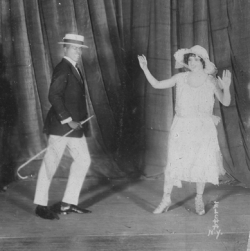
Lottie Gee, with Bob Lee, in a scene from Shuffle Along
People don’t generally know that at the beginning of her career Josephine Baker was not a sex symbol, she was not the figure that she became in Paris. She danced comically at the end of the chorus line, usually crossing her eyes, moving awkwardly, and playing to the audience – which proved to be tremendously successful, but it played to the Black stereotype of the clumsy, backwoods woman rather than the sophisticated diva she became.
Paul Robeson’s connection was a little more tenuous. A vocal quartet called the Four Harmony Kings were part of the show, and when the bass singer got sick and they needed a replacement, they knew of this young guy, Robeson, who had just graduated from Rutgers and who had a really good voice. Apparently, the first day Robeson went on stage Eubie told him to not look at the footlights because he’d be blinded, but he forgot that piece of advice and literally fell off the front of the stage. So, that’s how green he was as an actor, but he very quickly became a major dramatic actor.
There were several others in the show. Florence Mills certainly would have been as famous as Josephine Baker had she not died so young. Gertrude Saunders was a big blues singing star of that period. And then there was Lottie Gee, who I’ve become very interested in because she was so celebrated and yet her career never really developed due to the racism, sexism, and other forces that worked against her. So, yes, Shuffle Along was a very important show, and not only for the actors. The choreographer Laurence Deas became a famous choreographer of Black shows, and in the orchestra were people like William Grant Still and Eubie himself. Because this was the first Black show on Broadway, they had access to the cream of the crop.
KB There are many other people through the decades who got their start at Shuffle Along and eventually became famous. For example, in the 1930s Nat King Cole was in a sort of rundown touring company of Shuffle Along that stranded him somewhere out west.
RC Just as a fun sidenote, Sissle later led a dance band and discovered Lena Horne when she was a teenager. He provided her with her first professional job and taught her how to appear on stage. So, Shuffle Along had a long shadow, no doubt.
JJM The show ran for over 500 performances…
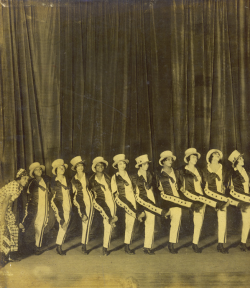
The Shuffle Along chorus line
KB Yes, it was the tenth longest running show of the 1920s, and considering Show Boat and so many other big shows were in the that decade, that was quite an accomplishment.
JJM Sissle and Blake had other work after Shuffle Along left Broadway, but throughout their career they attempted to revive it, but never successfully. Was that because of its artistic challenge, or was it due to financial reasons?
RC What initially happened was that Miller and Lyles were offered a very lucrative offer to separate from Sissle and Blake, and actually left Shuffle Along while it was touring following its New York run. There were some hard feelings about that because it was a situation where the composer and lyricist – Blake and Sissle – got royalties from the music in addition to what they’re being paid for the show, so Miller and Lyles felt they were shorted. They went on to do a show called Running Wild, which was famous for introducing the dance and song “The Charleston,” written by James P. Johnson.
The program for the 1924 production The Chocolate Dandies
So, Sissle decided that their next show would be even grander. Chocolate Dandies was designed to be just as big and elaborate as a white show – which meant that it was very expensive to produce – and ironically there was an expectation that it would be another rowdy, low comedy like that found in some elements of Shuffle Along, but instead, they presented this very grand, almost white show, and they were criticized for being Black artists trying to be white.
From that point on, the Sissle and Blake partnership broke up. Sissle discovered that he preferred to be in Europe where there was a lot less racism and where he befriended people like Cole Porter, who got him set up at a pretty fancy nightclub in Paris called Les Ambassadeurs. Eubie was more of a homebody and didn’t want to go to Europe. Then the Depression hit, and the door that had opened for Black shows closed. In the coming decade, while Shuffle Along was what they were most famous for and allowed them to get their feet in the door, things were changing all around them musically and socially, so the Miller and Lyles type of comedy found in Shuffle Along was hopelessly dated and couldn’t have possibly been staged with its original script. So, they were caught in this bind, where if they wanted to try to get back on Broadway they really had to use that show as their calling card, but on the other hand, as the decades passed it became harder to actually stage a show like that. Eubie was very fortunate in a way because as that style was declining on Broadway, the ragtime revival began after World War II and saved him as a performer. By then, Shuffle Along was pretty much forgotten.
KB I always like to point out that at the end of the 1920s, when sound pictures came in, it was all Broadway people – Harry Warren and Rodgers and Hart and Cole Porter – who went to Hollywood, but Black composers like Sissle and Blake and Fats Waller and others were never asked to go to Hollywood. So, during the Depression the white songwriters had plenty of money because they were writing for the Hollywood studios when Hollywood was booming, whereas Broadway was dying until the mid-to-late- 1930s, when things started to open back up.
RC A telling example of this was that Eubie wrote a song with Jack Scholl – a young, greenhorn songwriter – named “You’re Lucky To Me,” which was used in the show Blackbirds of 1930. The song became a hit right away, and Scholl was immediately invited to Hollywood to be a lyricist and screenwriter. Eubie wasn’t. So, there was such incredible, unbelievable racism at work that even a star as big as Duke Ellington never had a real shot at working in Hollywood.
.
A video interlude…Watch Eubie Blake (piano) and Noble Sissle perform “Affectionate Dan,” an early 1920’s film by Lee De Forest
.
JJM Sissle and Blake are in a 1920s film performing two or three songs…
RC Yes, Lee De Forest was a champion of a new sound system, and he made some experimental films, including some great footage of Sissle and Blake performing at that time. They also made a Vitaphone short which sadly has not yet been found. Hopefully someday it will be.
JJM The show Eubie opened in 1978, and eight or ten years prior to that the Columbia Records producer John Hammond had Eubie in the studio to record an album called The Eighty-Six Years of Eubie Blake. So, his late-life career experienced quite a revival…
The Eighty-Six Years of Eubie Blake
KB The great thing about Eubie was that he was a born showman. He loved to give people what they wanted, and he was great at it. He was better than any of the white ragtime people like Joe “Fingers” Carr or Max Morath – he was the real thing. The 1920s started coming back in vogue during the 1960s, even in fashion, with the straight-line dresses and jewelry. Eubie came in on that wave, but he was unique because Scott Joplin and all of the masters of ragtime and jazz from that period were pretty much gone. Eubie remembered everything and he could be very entertaining. He was on the Tonight Show a lot because he could carry his own weight – Johnny Carson didn’t have to do all the work.
RC It’s a combination of luck and talent. There was this sort of underground group of people who promoted Eubie. Rudy Blesh, who was famous for writing They All Played Ragtime and who was one of Eubie’s biggest boosters, arranged for him to play at the Newport Jazz Festival in the late 1950s. Another person was David Jasen, who worked as a tape editor for CBS News, and he would run into John Hammond at Christmas parties and tell him that he should record Eubie, and if Columbia didn’t, he would. So, Hammond finally broke down and arranged for the session. Eubie’s second wife, Marion, was also very important in his later life. She was extremely well organized – she arranged his travel, kept logs of all of it, and made him sit down and practice the piano every day.
Eubie also had an incredible memory, and able to remember things that happened sixty years earlier, which is pretty amazing. And he was long-lived, so all of those things made him particularly lucky. There were other people in that era that were rediscovered – like Willie “The Lion” Smith – but they weren’t as good entertainers or as easy going. Eubie had this combination of being very endearing and attracting people to him who helped promote his career.
KB Also, late in life he started learning the Schillinger System of writing music and playing, so his skills were better than anybody else at the time. His talent allowed him to play anything – he could play the “Star Spangled Banner” in ragtime, or people would name any song and he could rag them. He was remarkable.
JJM I’m sure you’ve spent years on this book. Do you have any favorite stories of Eubie Blake you’ve learned from this experience that you’d like to share?
RC Well, there are a lot of famous quips and stories related to him. He was an outrageous ladies man, and when he was in his early 90’s someone asked him, “When does the male sex drive decline?” Eubie quipped; “You’d have to ask someone older than me!” So, he was he was quite the character, and there are hundreds of wonderful stories about him.
We were talking to the ragtime historian Terry Waldo, who told us about the time Eubie gave a concert to promote his young protégés, and right before the concert, he was in pain to the point of bleeding, yet he still went on and played the show. Afterwards, he was taken to the hospital and Terry went over to check on him and asked him why didn’t he call the concert off? And Eubie said that if they hire me and pay me I’m going to play, but also, he wanted to make sure everyone else had a chance to play.
KB Very early on, Eubie met Irving Berlin in Atlantic City, and he sort of gave Berlin tips about things like syncopation that Berlin didn’t know. So, he even influenced Irving Berlin, which is pretty amazing. Berlin of course wrote “Alexander’s Ragtime Band,” and the name “Alexander” was a buzzword for being Black. Anytime Alexander was in a popular song and meant that the character was Black.
RC And he described Berlin as the skinny guy with yellow shoes…
KB That’s right. He was truly a remarkable man in so many ways.
.
.
photo courtesy of the authors
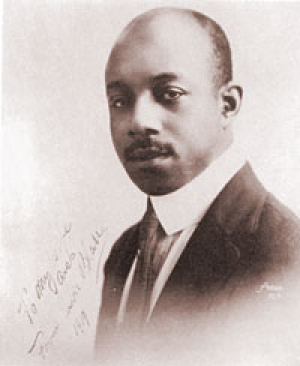
“When Blake passed, he had achieved his goal of reaching the century mark (although actually falling four years short of that landmark). His friend Louis Jacobs remarked, ‘Blake was pushing himself to reach 100. For the last year and a half, that’s what he talked about.’ Of course, Eubie knew his real age by then, but the legend of his 100 years was deeply etched into his life story and – as many noted – few could claim to be an active, acclaimed performer-composer whose career spanned an entire century. Blake’s legacy as a promoter of African American music and performers and his insistence that their music be judged by the same standards as white musicians lives on – as do many of his best songs and ragtime pieces. To say that this goal has been reached would be untrue, but his life remains an inspiration to all who hope someday we will reach beyond dichotomies of color, religion, and race to a world where all artists can thrive.”
– Richard Carlin and Ken Bloom
.
.
Watch a 1972 concert film of Eubie Blake performing his composition “Memories of You”
.
.
___
.
.
Eubie Blake: Rags, Rhythm and Race (Oxford)
by Richard Carlin and Ken Bloom
.
.
Praise for Eubie Blake: Rags, Rhythm, and Race
“Along with many others, I have been waiting for a new, scholarly, thorough, and insightful biography of this one-of-a-kind American figure. Finally, we have one, nicely-illustrated and carefully documented.”
– John Edward Hasse, author of Beyond Category: The Life and Genius of Duke Ellington
.
“Carlin and Bloom have created an all embracing and unique musical chronicle of Eubie Blake that is compelling, heartbreaking and ultimately joyous thanks to his late life rediscovery. With the use of voluminous first hand research artifacts, they have created a multi-faceted account of Blake’s life and in the process, have given us one of the truest depictions of the endemic racism and cut throat culture of 20th Century show business.”
– Michael Feinstein, American singer, pianist, and music revivalist
.
.
___
.
.
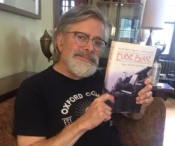
Richard Carlin is a Grammy Award-winning author of numerous books on popular music, including Country Music: A Very Short Introduction (OUP, 2019), The Big Book of Country (1995), and Worlds of Sound: The Story of Smithsonian Folkways (2008).
.
.

Ken Bloom is a Grammy Award-winning author of Show and Tell: The New Book of Broadway Anecdotes (OUP, 2016), Broadway Musicals: The 101 Greatest Shows of All Time (2004), and Broadway: An Encyclopedia (2004). He is the co-founder of Harbinger Records, has been a Broadway correspondent for NPR and the CBC, and has directed and produced shows at Town Hall, the Brooklyn Academy of Music, among other venues.
.
.
___
.
.
This interview took place on April 2, 2021, and was hosted and produced by Jerry Jazz Musician Editor/Publisher Joe Maita
.
.
If you enjoyed this conversation, you may want to read an interview with Richard Crawford, author of Summertime: George Gershwin’s Life In Music
.
.
.




